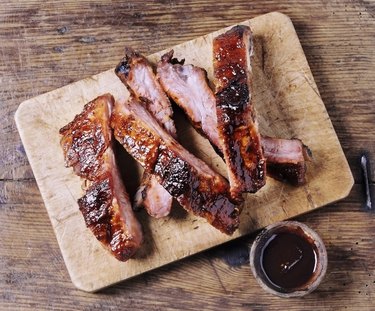
Boiling pork spare ribs before placing them on the grill or in the oven gives you more control over the cooking temperature. This helps ensure the ribs will be tender and juicy. Boiling not only shortens the cooking time but makes the meat easier to chew and digest.
Tip
One way to tenderize pork spare ribs is to boil them, which should take about one and a half hours per pound of meat — or less for boneless ribs. Ideally, cook the meat until it reaches a minimum internal temperature of 145 degrees Fahrenheit.
Video of the Day
Pork Spare Rib Nutrition
Connecticut's Department of Consumer Protection defines spare ribs as the cut of meat at the bottom portion of the pig's mid-section from the fat back side of the belly, including portions of the rib cartilages and possibly a part of the split breast bone.
Video of the Day
Loin back or baby back ribs are cut from the top of the rib cage and are meatier, bigger and require a longer cooking time. Each full slab of spare ribs contains 12 bones, according to the University of Nebraska-Lincoln.
Cooked pork spare ribs are high in calories and fat. According to the USDA, 100 grams or a 3.5-ounce serving, delivers 397 calories — that's about 20 percent of the daily value (DV). In comparison, pork back ribs provide 292 calories or 15 percent of the DV for the same amount.
Most of the calories in pork ribs come from fat. Pork spare ribs are meatier than back ribs and contain 30.3 grams of fat plus a hefty amount of cholesterol — 121 milligrams or 40 percent of the DV. The U.S. National Library of Medicine states that if you are trying to lower your cholesterol, you should limit your intake to 200 milligrams a day.
Any carbs or sugar you get from pork ribs will come from the sauce and other ingredients you add to the mix. The meat is carb-free. Spare ribs are a good source of protein, offering 40 percent of the daily recommended value for this nutrient in each 3.5-ounce serving.
Purpose of Boiling Ribs
Whether you are boiling boneless pork ribs or bone-in spare ribs, cooking ribs on the stovetop causes the connective tissues and membranes to break down, according to a January 2018 research paper in Comprehensive Reviews in Food Science and Food Safety.
Heat also helps render surface fat and makes it easier to remove the inner membrane from the ribs (if necessary) before you grill them. Furthermore, it softens the overall texture of the ribs and ensures they are cooked at a safe internal temperature to destroy bacteria.
When cooking ribs on the stovetop, keep the water at a simmer rather than a full boil. As noted by ScienceMeetsFood.org, muscle fibers in the meat begin to shrink at a temperature of about 100 F. As the temperature rises to 130 F, the collagen, which is responsible for the toughness in meat, begins to contract and denature. It turns into a gel-like substance that helps tenderize the meat.
However, according to the American Meat Science Association, if you allow the water to exceed 195 F, such as when boiling water (which requires 212 F), the protein in the meat toughens.
Cooking Ribs on the Stovetop
The key to succulent pork ribs is a lengthy cook time and a simmering temperature — low and slow — which is easier to control on the stovetop as opposed to grilling. Adding salt, peppercorns, bay leaves, a clove of garlic or ginger, and other herbs, such a sprig of rosemary or thyme, to the water will enhance the flavor.
Slowly boiling ribs submerged in a pot of water may take one and a half hours per pound of meat, according to a recipe from the Splendid Table. Cooking boneless ribs will not take as long.
The USDA states that meat should reach a minimum internal temperature of 145 F to be safe for consumption. However, you might have to bring it to a higher temperature for optimal tenderness. The meat is done when it pulls back and exposes a bit of bone at the thinner ends of the ribs. Also, the ribs should bend slightly at the center when picking them up with tongs — but should not fall apart.
When the ribs are ready, remove them from the water and pat them dry. Brush the ribs with BBQ sauce or flavor them with a spicy dry rub of your choosing. Place them in the oven at 400 F or on a hot grill.
Cook, turning once, until the sauce sticks to the ribs, becomes golden brown and caramelized with just the right amount of crispiness around the edges. Once they're done, remove them from the oven or grill and let them rest for at least three minutes before cutting them into portions.
Read more: How to Make Ribs in a Slow Cooker in 4 Hours
- USDA Food Safety and Inspection Service: "How Temperatures Affect Food"
- University of Nebraska - Lincoln: "Pork Cuts ID & Cooking Recommendations - Spareribs and Jowl"
- USDA: "Nutrition Comparison of Roasted Pork Backribs and Pork Spare Ribs"
- U.S. National Library of Medicine: "How to Lower Cholesterol With Diet"
- Comprehensive Reviews in Food Science and Food Safety: "Domestic Cooking of Muscle Foods: Impact on Composition of Nutrients and Contaminants"
- Science Meets Food: "The Science Behind Sous Vide Cooking – And How to Explain It to Your Friends"
- American Meat Science Association: "Meat Cookery - Methods of Cooking Meat"
- Splendid Table: "Sticky, Spicy Pork Ribs"
- Regulations of Connecticut State Agencies: Department of Consumer Protection: "Labeling of Cuts of Meat Sold by Food Establishments"